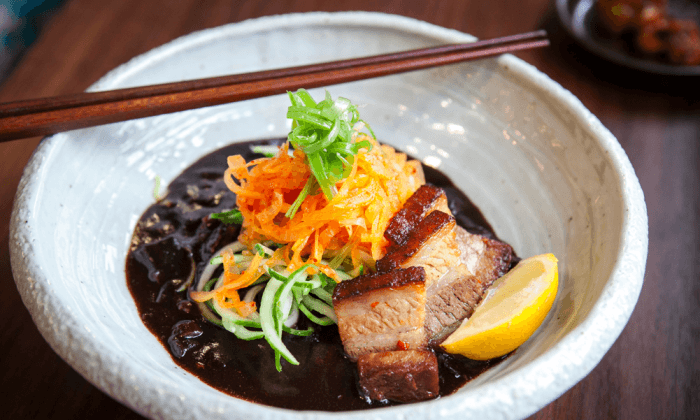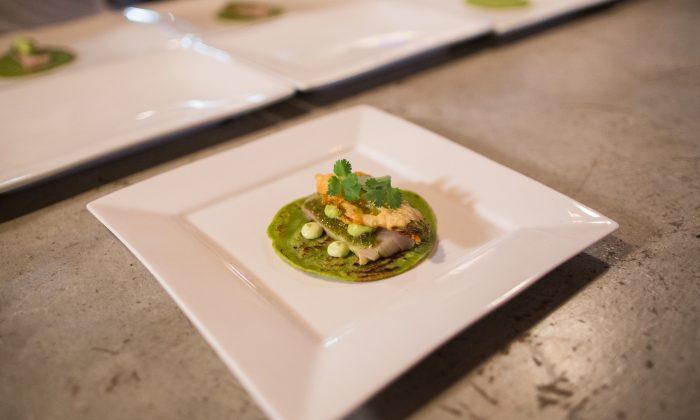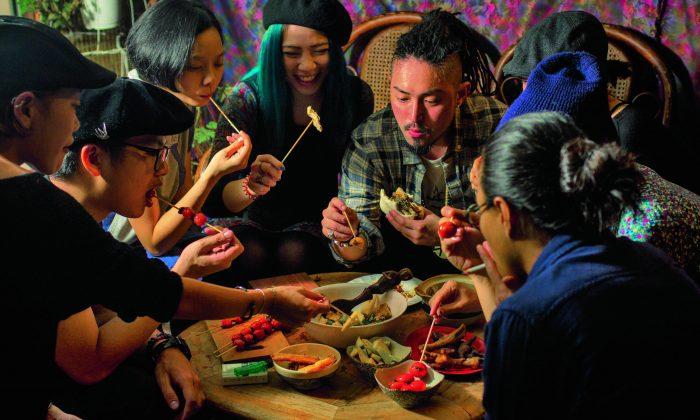At Mokbar, fermentation rules. The alchemy takes place discreetly out of sight, in pots and jars in a prep kitchen reachable through a labyrinthine path downstairs at the Chelsea Market.
Here stocks simmer anywhere from 8 to 30 hours, pickles ferment away for weeks on end, each with its own schedule and vexing sensitivities. One dish, demanding such a series of steps and techniques that would drive a home cook mad, takes as much as a month to put together.
But with time as an ally, chef and owner Esther Choi cooks up complex, nuanced flavors, sometimes surprising—nothing short of a cure for a jaded palate in need of a reawakening.
Even an unassuming appetizer like the Ho Cake ($6), with the humble look of a street food, hides its true depth and complexity.
But one bite, and it presents a terrific explosion of flavors, of a crispy golden exterior yielding to a light fermented dough bejeweled with sweet pieces of tender braised pork belly.
An accompanying bright orange sauce provides the perfect foil and is in itself a masterful balance—all at once sweet, savory, spicy, acidic—the amalgam of housemade kimchi, Fuji apples, chilies, rice vinegar, and deepened by a period of fermentation.
Like all the items on the menu, the Ho Cake is Choi’s own take on a traditional Korean dish. In this case, she was inspired by a street snack from her youth in Korea, hotteok— traditionally filled with nuts, syrup, and cinnamon—and created a savory version.
Distinctively Korean Ramen
Like the Ho Cake, Mokbar isn’t quite what it seems. On the surface, it’s a ramen bar but whose heart and soul is Korean. The restaurant, whose name means “eat bar,” opened this April.
It comes with a caveat, namely that if you’re looking for a Japanese ramen experience, you won’t find it here.
Like many ramen bars, Mokbar sources ramen noodles from Sun Noodles, but the similarity ends here. The noodles are used as a vehicle, a surreptitious (or not so surreptitious) way to introduce guests to Korean cuisine—beyond well-known barbecue, which Choi points to as a modernized dish.
A taste of the pork broth-based Classic ramen ($14), and it’s no run-of-the-mill ramen. Korean flavors dominate all the way: dried anchovies provide some of the umami in the broth, and the pork is marinated in gochujang, a Korean chili paste. The toppings recall bibimbap.
Choi sources her gochujang, doenjang (known as the Korean version of miso), and soy sauce, from an artisanal local producer, who makes MSG-free versions, fermented anywhere from 12 to 18 months, and adapts them to her specifications.
There’s no shyness about any of the dishes. The Black Ramen ($13), Choi’s take on the sweet-savory Korean jajangmyeon noodle dish, has the boldness of fermented black beans, with bacon, zucchini, onion, and potato, and topped with cucumber, pickled daikon, scallion, and pork belly, with lemon.
With the summer in full swing, Choi has also introduced cold noodle dishes.
One of them, the chilled beef ramen soup, takes about a month to put together.
It’s been in the works for years, slowly simmering in her thoughts. Choi, who watches Korean food documentaries in her downtime while nursing a beer, became obsessed with a particular segment on oxtail kimchi, or kimchi fermented with beef broth.
“I think I watched that thing at least 50 times, over and over. My sister thinks I’m totally insane. ‘How can you watch that after you’ve been cooking all day at your restaurant?’ I don’t know, either,” she said, laughing.
“It’s my genuine love for it. I’m always reading about traditional way of making things.”
Finally, she decided to make kimchi in an oxtail and bone marrow broth.
“If you eat the kimchi it has a very distinct taste. I wouldn’t say beefy but very—I don’t know, can’t describe it—it’s just delicious,” Choi said.
The fermented broth is made into a stock for the soup, and then augmented with dashi and tomato. It’s topped with a soy sauce egg and brisket and the oxtail kimchi.
It is somewhat like the lightest gazpacho, and has a silky mouthfeel from the stock, but lighter than one might imagine from beef—a subtle texture and flavor. If anything it shows how Choi handles subtle as well as bold flavors. The noodles are thinner, lighter, springier than the ramen noodles—a perfect complement for the dish.
Newcomers might go for the bulgogi, which just debuted on the menu, but the menu, albeit short, offers plenty for the curious.
The gluten-free and vegan diners have options as well—the noodles can be replaced with rice (which is how Choi often opts for her own meals) and the vegan ramen is a hit that she didn’t expect to be popular.
Anju
If you go for the ramen, make room for the other dishes as well the “anju,” which is really meant to be drinking food. The Ho Cake is a must, but others are compelling, too.
Rice cakes, traditionally served chewy, are enormously improved by Choi’s treatment. Sautéed in brown butter, they acquire a nuttiness and crunchiness that I’ve never encountered with rice cakes.
There is just an eye-opening, sweet-spicy note to the rice cake dish (Tteok Boki, $12), made all the more difficult to put down with the addition of crispy bacon. (“I love bacon so much,” Choi said.) Minced pork, white kimchi, and a poached egg round out the dish beautifully.
Choi’s New Jersey background manifests itself in the Disco Fries ($12), which demand being paired with an alcoholic drink—maybe one of the fruit-infused sojus that Choi makes. The fries come with ramen gravy, cheese curd, and topped with kimchi, and nori.
A lighter and more forgiving option if you’re planning to eat a lot more would be the seasonal banchan, a trio of plates, that can run the gamut from cucumber salad to warm squid salad ($12).
There are also nonalcoholic options, which are outstanding and refreshing: a strawberry yuzu iced tea (more for adults than children) and a ginger-apple iced tea, which also gets the benefit of fermentation for some time ($3).
The Alchemist’s Laboratory
Downstairs, Choi operates a veritable laboratory with the aid of microbial life, with fermented broths, pickles, and doughs with different demands. It sounds like a lot of simultaneous high-maintenance relationships to me, which is exactly what it is, as it turns out. Choi tastes her batches twice a day, adjusting as needed.
The pork-based mother stock simmers long and low for 30 hours. The pot of milky white chicken stock, which goes for 8 hours, is filled with chicken parts, carrots, onions, and ginseng. Used for the chicken ramen soup, the dish is based off samgyetang, and traditionally eaten in the summer in Korea.
Don’t get her started on the dough used for the Ho Cake. “The Ho Cake dough is such a headache because if the weather is even off by five degrees, I have to change the whole thing,” Choi said.
Choi learned to cook from her grandmother. “I’ve been making kimchi since I can’t remember,” she said.
Food was always a central affair in her family. “Once or twice a year we would come together and make a big batch of kimchi. Every New Year we would make thousands of dumplings. We'd just sit there and make dumplings—the whole family. For me growing up it was like that all the time. Being in the kitchen was very natural. I genuinely loved it ever since I was little.”
She is adamant about not using MSG other than the MSG that is generated naturally in sources like dried mushrooms, kombu, or dried anchovy.
She’s hesitant to say this but says it anyway: Asian restaurants—especially Korean, Japanese, and Chinese—all use MSG unless they market themselves markedly as not using any.
Not resorting to the easy use of artificial MSG, but rather choosing to develop flavors slowly over time, with natural and sometimes finicky fermentation and aging processes, makes for complex, earthy flavors.
But she noted, “It’s a constant battle, though. It’s really hard sometimes not to try to get away from that, because everyone wants it all the time.” Commercial staple items like chili sauce or kimchi contain MSG, for example.
“I have to constantly be on my A-game—with all sauces, all my food, my kimchi, everything I make,” she said.
“I have to compete with all these restaurants that do use it. It’s easy because all you have to do is add it and it tastes good. For me it’s about being true to who I am,” Choi said.
Mokbar
Located inside Chelsea Market
75 Ninth Ave.
Mokbar.com
Hours:
Daily 11 a.m.–11 p.m.





